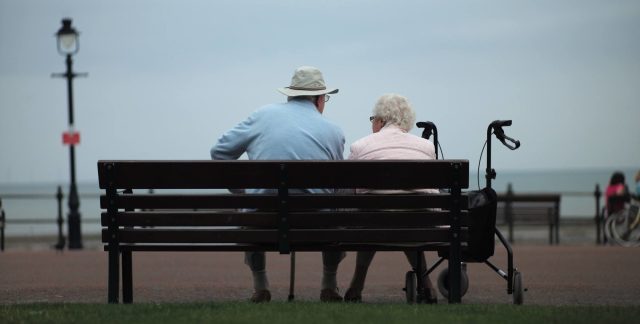It’s their country baby, you’re just living in it. Credit: Christopher Furlong/Getty

A few years ago a friend of mine explained to me that she was spending her Thursday evenings drinking cocktails with nonagenarians.
She worked hard all week, she said, and enjoyed her weekends. She liked spending time with her friends and she was happy with her life in London. But often she would look around her at her fellow commuters, shoppers, drinkers and diners and ask herself: where are all the old people? And that question would trigger unnerving feelings of sadness, guilt and loneliness.
So she did something about it, and signed up to a charity initiative which got young people to go to the local hospice to share drinks, talks and dancing with the geriatric residents.
The lack of contact between young and old is a recognised and serious social problem. And it is closely related to arguments about intergenerational unfairness – indeed the UK think tank the Resolution Foundation has called for “a new generational contract” aimed at giving the young a better deal.
But how can there be a sense of solidarity between generations if there is so little contact between them? And how can there be more contact if the young and the old are living in different places?
Recent research by the Centre for Towns has starkly demonstrated that our cities are getting younger while our towns are getting older. Since 1981 the number of people aged 24 or under living in small towns has decreased by 270,000. And yet there are around 1.3 million more people in small towns aged over 45.
And if you look at the big ‘core’ cities – not just London but Birmingham, Manchester, Leeds and the six other major metropolitan hubs in the UK – they are home to around 1.8 million more people than in 1981, but there are nearly 200,000 fewer people over the age of 65. That’s despite the well documented ageing of our society – there are over two million more people aged 65 plus than in 1981, and yet cities have seen a fall in the numbers of old people living in them.
The trend is shown most clearly in the old age dependency ratio, which measures the number of people aged 65 or over per 100 people of working age. Up until around 1990 this ratio was fairly similar across different types of settlement, from village to core city. But ever since then, the smaller the settlement the higher the old-age dependency. In villages, it’s up to 36. In cities, it’s down to 19.
Some may not be worried about this – perhaps it is OK for every major city to look, demographically speaking, like a university, and every small town to look like a Florida retirement community. But we are living in an age of ever-increasing polarisation, with those who voted to Remain in the EU pitched against those who voted to Leave, graduates against non-graduates, Left against Right, and yes – young against old.
And on top of this it is an age of fragmentation and isolation. Echo chambers on social media, the slow death of the high street and the disintegration of collective institutions like unions and churches have left us with ever fewer places where we can talk across social difference. In that context, the age divide in cities and towns becomes less an oddity, and more a serious social crisis. In fact, most of these divides – from the electoral divide to the higher education divide – are encapsulated by the divide between cities and towns.
Cocktail parties in hospices, however well meaning, will not be enough to provide the bridge between young and old – we have to slow or reverse this trend of growing geographic division.
And to do that, we have to look at the economy. Graduates are flocking to cities (and smaller research centres like Cambridge) because that is where there are jobs and opportunities. Until we have an economy which provides decent work everywhere, age segregation will only get worse.
Within public policy, there are initiatives which are aggravating the divide between cities and towns. The government’s industrial strategy is supposed to do something about the stark regional imbalances in the country. And yet it is dominated by investment in high-tech industries which inevitably cluster in cities and already successful research centres. Devolution sounds like it might do something about the town-city divide, but as research by the New Economics Foundation shows, it is focused on empowering city centres, not the places around and outside cities that most need it.
We need an economy which gives people the space to work decent jobs and live decent lives wherever they are, not force them to live in metropolitan hubs while leaving the rest of the country to hollow out.
That means building transport and housing which supports towns to flourish and doesn’t just drain them of investment, talent and energy. And it means pursuing a devolution agenda which gives real power to smaller towns so they can build on local knowledge and create resilient local economies.
Ultimately, it means taking towns seriously again. These are places which, like all places, have meaning for those who grow up there. They are powerful sources of identity and belonging. As long as we have an economy which works ceaselessly against this sense of belonging, and which pushes nearly all young people – no matter their preferences – into major cities to look for work, then we will remain a fundamentally divided country.










Join the discussion
Join like minded readers that support our journalism by becoming a paid subscriber
To join the discussion in the comments, become a paid subscriber.
Join like minded readers that support our journalism, read unlimited articles and enjoy other subscriber-only benefits.
Subscribe